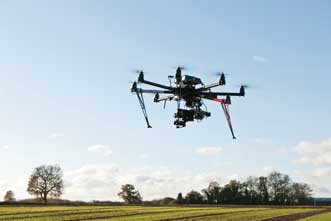Sometimes taking to the skies is the best way to see what’s happening on the ground.
Rothamsted Research of Harpenden, England, hopes that will be the case for crop studies: The agricultural research institute has obtained a remote-controlled unmanned aerial vehicle (UAV) called an octocopter, outfitted with four different cameras, to further its work in the fields. Two of the cameras can send a live feed to a monitor on the ground at any time.
Eight-rotor battery-powered UAVs such as the octocopter are fairly common in the film industry, but less so on farms. One camera takes video and still images to help the operator identify where the UAV is flying, via goggles. The other three cameras – a high-definition RGB camera, a thermal IR camera and a hyperspectral camera – are mounted on a stabilized, remotely tiltable platform.
The custom-built equipment will enable high-throughput data collection from experimental crop plots at each of the institute’s sites as well as at trials for collaborating organizations. The data will offer unique perspectives on crop growth and plant functioning, and will vastly extend capabilities for screening crops of different genetic background for performance, nutrition, stress, pathogens and disease responses, the institute said.

The octocopter at Rothamsted Research is a standard eight-rotor battery-powered unmanned aerial vehicle with four cameras attached to monitor crops for research purposes. Photo courtesy of Rothamsted Research.
“The UAV will be deployed over the full range of crops studied at the institute and will enable detailed evaluations of growth and functioning of the plants,” said Dr. Malcolm Hawkesford, lead scientist of Rothamsted’s 20:20 Wheat Program, which aims to increase UK wheat yield potential to 20 tons of wheat per hectare within the next 20 years.
“It will enable multiple measurements to be made within a short space of time with preprogrammed low-level flight paths,” he added. “It is anticipated that many thousands of plots will be monitored sequentially or in parallel in blocks in projects currently screening germplasm variation amongst thousands of lines combined with multiple treatments and replications.”
The impact will be felt not only by the wheat project, but by several other efforts as well. “The technology will substantially increase throughput and precision of analysis, and make a substantial contribution to current programs of crop improvement including 20:20 Wheat, Cropping Carbon, Sustainable Systems and the cross-institute WISP (Wheat Improvement Strategic Program) project,” said professor Maurice Moloney, who, at the time, was director and chief executive of Rothamsted Research (he has since become group executive for the food, health and life science industries at the Commonwealth Scientific and Industrial Research Organisation in Australia). “The technology will complement ground-based measurements initially, but, eventually, aerial-based observation will replace the need for low-throughput non-automated manual measurement.”
The octocopter was purchased with funding from the Biotechnology and Biological Sciences Research Council (BBSRC).